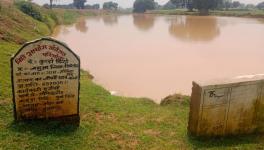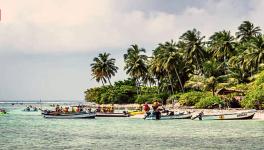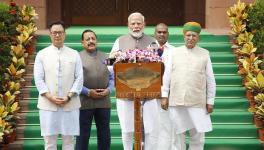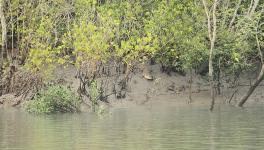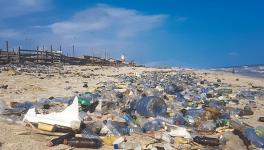#World Environment Day: Lakshadweep Happenings -- The Big Plot
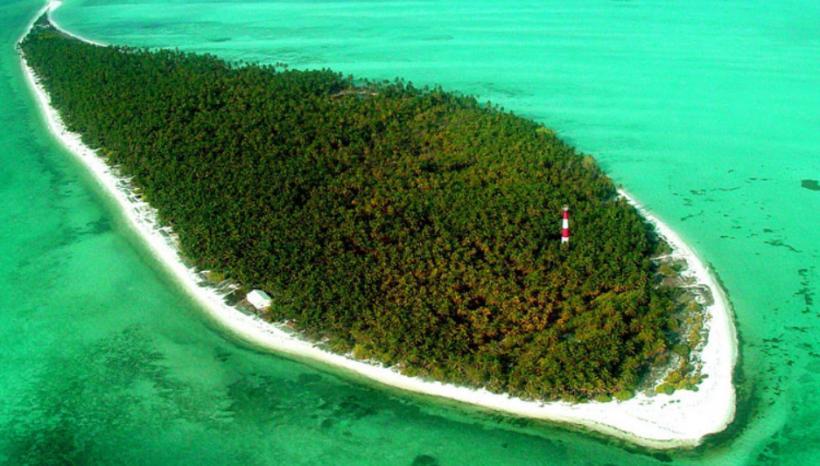
The World Environment Day falls on June 5 each year, and the theme for the coming decade has been declared as “Ecological Restoration.” It is indeed a tragedy that this article, written in commemoration of the Day, draws attention to the ecological and human disaster unfolding in the Lakshadweep archipelago in the Arabian Sea, as well as in the Andaman & Nicobar island chain on the eastern flank of peninsular India in the Indian Ocean, in the name of “island development.”
Many articles have appeared in the past week or so, including on this site, on the series of unprecedented, arbitrary and deeply disturbing actions of the recently appointed Administrator of Lakshadweep. Praful Khoda Patel, the first political appointee to this post in the Union Territory, had earlier served as Home Minister in the Narendra Modi-led Gujarat government during the period the previous Minister Amit Shah had to step down due to investigations into an alleged fake encounter case.
While the measures taken by the Administrator are by now well-known, they bear brief repetition so as to underline the savagery of the assault on the rights and culture of people of Lakshadweep, seemingly designed to crush any actual or potential opposition to “development” plans being contemplated, and to make clear that the local population of Lakshadweep counts for nothing in the scheme of things.
Some larger and uncomfortable questions remain, particularly regarding the nature of the envisaged “development” plans and the interests behind them, and deserve to be discussed more than has been done hitherto.
Wholesale assault on the local population
The Administrator has drawn up, and sent to the Home Ministry for approval, a new Lakshadweep Development Authority Regulation 2021 and a whole raft of other draft Regulations on Panchayats, Prevention of Anti-Social Activities (PASA),” and Animal Preservation.
Together, these assign unquestionable authority to the Administrator, including giving him total eminent domain powers over the territory and people of the Islands, enabling the administration to take over any part of the islands in the name of “development activities”, including ecologically damaging mining and extraction of mineral resources; to forcibly remove or relocate any islander owning that land, despite the fact that over 95% of islanders belong to Scheduled Tribes whose lands cannot be easily alienated; to bypass panchayats and other local government bodies; and, amazingly, placing any such actions by the Administrator beyond appeal or judicial review.
Customary prohibition in the Muslim-dominated islands has been relaxed. And the mostly COVID-19 free islands now have over 7,000 cases due to the Administrator’s arbitrary relaxation of restrictions hitherto.
The Administrator claims that all these measures have been taken in pursuit of development of Lakshadweep “along the lines of the Maldives.” His plans, so far unchecked by the Home Ministry under which the UT administration functions, mark out a developmental model which is sought to be imposed on the Lakshadweep group, even if contrary to the express wishes of the local people who are seen as dispensable in their island home viewed purely as real estate.
The new and sweeping powers arrogated by the Administrator, and the heavy-handed repression unleashed by him, reveal an impending blitz of large-scale projects, and are aimed at pre-emptive throttling of local opposition to them and undermining long-term potential for democratic governance and policy-making in the Islands.
These proposals have been rejected in toto by the islanders, but protesters have been arrested and incarcerated without trial using the PASR or “Goonda Act.” Local artisanal fishers have been attacked and their nets, gear and huts destroyed in the name of coastal regulations. Thousands of contract workers have been summarily laid off.
Other gratuitous measures have been taken by the Administrator, include banning the sale, storage or consumption of beef, integral to the food habits of the overwhelmingly (95%) Muslim population with ST status; removing non-vegetarian food from school meal programmes; and closing down the islands’ only government-run dairy farm and ferrying milk from Gujarat instead.
There is also a clear attempt to de-link Lakshadweep from its historical links with Kerala, with Malayalam being the lingua franca, by diverting supply ships from Beypore Port near Kochi to Mangalore in Bharatiya Janata Party-ruled Karnataka.
All these measures show that the Administrator is hell-bent not only on stamping out dissent by acting in anticipation of the sweeping powers being approved by an apparently supportive Home Ministry, but also on severely undermining the local culture and way of life, and the democratic roots of local governance and popular mobilisation in Lakshadweep.
NITI Aayog Plans for Islands
These columns had a few months ago discussed the completely non-transparent plans developed and pushed by government think-tank NITI Aayog for Island Development not yet available in the public domain, but had then largely focused on the plans for the Andaman & Nicobar Islands. It is now necessary to look at the proposals for the Lakshadweep group.
Following preliminary studies by NITI Aayog itself, its CEO made a presentation to potential investors in August 2018, stating that the government had accorded “high priority” to the development of the islands and was putting forward concrete and carefully worked out project ideas.
The government had constituted an Island Development Agency in June 2017, under the chairmanship of the Union Home Minister, which had mandated NITI Aayog to steer the programme for “Holistic Development of Islands.”
Further, in order to ease the path of investors, local Island Development Authorities had been empowered to provide single-window facilitation to projects, with pre-obtained regulatory clearances for land use, environmental impact and so on!
It is strange how a body conceived as simply a government think-tank to replace a Planning Commission viewed as a centralised and “socialistic” body with powers even for allocation of plan funds to States, has now been transformed into a centralised project planning and implementation oversight body with quasi-executive powers outside all existing government structures and accountability only to the Home Minister.
In January 2019, the government announced that “final Site Potential Development Reports” have been prepared for four islands in Andaman & Nicobar (A&N), namely Smith, Ross, Long and Aves Islands, and five islands in the Lakshadweep group, namely, Minicoy, Bangaram, Thinnakara, Cheriyam and Suheli Islands. A new airport at Minicoy has now been initiated along with Maldives-style water-villa projects in Minicoy, Suheli and Kadmat in the Lakshadweep group, as confirmed by the Administrator.
NITI Aayog also conducted further studies toward detailed projects, with some details contained in a May 2019 “think” report by NITI Aayog staffers titled “Transforming the Islands through creativity and innovation.”
It should be clarified that the projects in the Lakshadweep group are mainly tourism related. After all, the group of 36 small islands comprises just 10 inhabited islands, 17 uninhabited islands, four newly formed islets and five submerged reefs.
By contrast, the A&N group consists of 576 relatively larger islands, of which only 38 are inhabited, some with only extremely isolated and almost non-contacted tribes. Plans for the A&N islands are extremely ambitious and fanciful, including several airports, container trans-shipment ports, a new greenfield city to act as a financial hub “on the lines of Singapore and Hong Kong,” with strategic value given proximity to the Malacca straits.
New Lakshadweep Model
The dream for Lakshadweep, although less ambitious, is unabashedly modeled after the Maldives, however inappropriate for Lakshadweep, or for the A&N islands, for a host of reasons beyond the scope of this short piece.
Briefly, the Maldives are a group of larger islands with a high-end tourism model with few links to the bulk of the island population although adding hugely to the Maldivian GDP (gross domestic product). After a few short decades of this model of tourism, the strains are already showing on local ecosystems, especially on the coral reefs, the very lifeline of the archipelago. A shift in fishing to large-scale trawlers has already wreaked havoc and has recently been banned. Small home-based tourist facilities have started cropping up in the main population centres, exposing the artificial and superficial super-imposition of the extant tourism model.
The NITI Aayog studies bemoans the fact that while domestic tourists have risen substantially in both the A&N and Lakshadweep islands, almost 400,000 and 10,000 annually, respectively, foreign tourist arrivals have stagnated at around 15,000 in A&N and 500-odd in the latter, despite great demand for water sports, game fishing and cruises.
In contrast, the Maldives host over 1.5 million foreign tourists annually. The point is, however, that mainland India offers a much wider set of attractions to international tourists, and could do much better in terms of hotel and transportation infrastructure to attract a wider range of tourist categories including for eco-tourism also involving the local population in more sustainable tourism models as in Kerala. Expansion of these mainland efforts in both quantitative and qualitative terms would also organically link up with island tourism with mutual benefit.
NITI Aayog also conducted further studies along with international agencies to assess the carrying capacity of islands identified for major projects. Without getting into methodological details, these studies projected potentially huge tourist inflows just of 5,000-10,000 persons per day in the A&N islands or around 1.5 million per year in each of several islands i.e., unimaginably, more than half the foreign tourist arrivals in the whole of mainland India! Other NITI Aayog studies apparently also confirm such high carrying capacity estimates.
This level can only be realised if all resources are ferried from the mainland, at huge cost to the local ecology due to deforestation, change of land use and disposal of the enormous quantities of wastes generated. With a large mainland back-up in India, the local population becomes virtually irrelevant.
Lakshadweep is already suffering from severe coastal erosion, and experts predict that some islands may become uninhabitable due to sea level rise related to climate change. Various other negative ecological impacts are also predicted by experts, such as coral reefs bleaching, damage to fish habitat and breeding grounds etc. But all this may not matter to NITI Aayog planners and their supporters in the Union government.
The Environmental Impact Assessment of Projects in the Little Andaman island records the enormous ecological risks to pristine local forests, mangroves, marine life and endangered species, such as Leather-backed Turtles, not to mention the endangered Onge tribe. Yet, the Union Environment Ministry has casually ignored all these, and has granted environmental clearance, coolly noting that the Onges can simply be relocated elsewhere. Clearly, in this model of island development, the environment matters little and the local population matters even less.
Threats to Lakshadweep and its people from these so-called “holistic island development” plans, are clear. In months to come, one may well see influential corporates descending on the Lakshadweep islands on the backs of a crushed local population, backed to the hilt by the UT administration with regulatory systems captured or strangulated.
Get the latest reports & analysis with people's perspective on Protests, movements & deep analytical videos, discussions of the current affairs in your Telegram app. Subscribe to NewsClick's Telegram channel & get Real-Time updates on stories, as they get published on our website.









